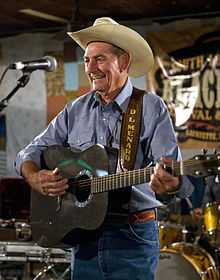D. L. Menard
| D. L. Menard | |
|---|---|
 D. L. Menard playing guitar at the 2008 Black Pot Festival. | |
| Background information | |
| Birth name | Doris Leon Menard |
| Born | April 14, 1932 |
| Origin | Erath, Louisiana |
| Genres | Cajun |
| Instruments | Guitar |
| Associated acts | Louisiana Aces, Le Trio Cadien |
Doris Leon "D. L." Menard[1] (born April 14, 1932) is one of the most important songwriters and performers in Cajun music. He has been called the "Cajun Hank Williams" because of the country-tinged sound of his voice and music.[2]
Biography
Menard was born in Erath, Louisiana. The only child[3] of Mr. Ophy Menard and Mrs. Helena Primeaux Menard.[4] He was part of a Cajun farming family. He started to play guitar at 16 and started playing dances in Louisiana clubs at 17.[4] He was greatly influenced by Hank Williams meeting him once in 1951 at the Teche Club[3] shortly before Hank's death.[5] Since then he has performed in more than 30 countries and served as a good-will ambassador for Cajun culture. He has also recorded with non-Cajun artists, including Bryan Ferry.[6] He and his wife Louella - now deceased - have seven children, seventeen grandchildren, and one great-grandchild.[2] He still lives in Erath and continues to play music. He has maintained a separate career as a craftsman, noted for his handmade ash-wood chairs he makes at his one-man factory in Erath.[4]
Style
Menard is known for his "tinny" voice and popular guitar strumming style. Anne Savoy generalizes Cajun guitar strumming to two styles: Old Time Style (Cléoma Falcon) and D. L. Menard Style.[7] It uses bass runs on chord changes and incorporates up strokes along with down strokes. He modeled his guitar strumming style after David Bromberg whom he met in 1973.[8]
La Porte En Arrière
Menard is best known for his song "La Porte En Arrière" ("The Back Door"), which Cajun folklorist Barry Jean Ancelet has called the most played and most recorded Cajun song, selling over 500,000 copies in 1962 alone.[9] It has been covered by dozens of Cajun and zydeco bands and by other Francophone artists such as Kate and Anna McGarrigle. Menard has said he modeled it on Hank Williams' "Honky Tonk Blues."[3] He composed it in under an hour, while working at a service station in Erath.[4]
Awards
In 1993, his album Le Trio Cadien was nominated for a Grammy Award in the Best Traditional Folk Album category.[10] In 1994, he was awarded the National Heritage Fellowship Award by the National Endowment for the Arts.[11] In 2009, he was inducted into the Louisiana Music Hall of Fame along with Jo-El Sonnier, Doug Kershaw, and Jimmy C. Newman.[9] In 2010, his album "Happy Go Lucky" was nominated for a Grammy Award in the Best Zydeco Or Cajun Music Album category.
Discography
45 RPM's
- She Didn't Know I Was Married / Bachelor's Life Swallow 45-10139
- The Back Door / I can't Forget You Swallow 45-10131
- Valse De Jolly Rogers / La. Aces Special Swallow 45-10121
- Rebecca Ann / I Can Live A Better Life Swallow 45-10147
- Too Late You're Divorced / Riches Of A Musician Swallow 45-10243
- The Vail and Crown Swallow 45-10249
33 RPM's
- Louisiana Aces (1974) Rounder Select 6008
- Cajun Hits Volume 2 (n.d.) Swallow LP 6003[12][13]
- En Bas Du Chene Vert (1976) Arhoolie Records
- The Best of Cajun Hits Volume 3 (1978) Swallow LP 6033[12]
- The Back Door (1980) Swallow LP 6038[12]
- Cajun Saturday Night (1984) Rounder Select 0198[12]
- No Matter Where You At, There You Are (1988) Rounder Select 6021[12]
Albums
- Le Trio Cadien (1992) Rounder Select
- Cajun Memories (1995) Swallow LP 6125
- Happy Go Lucky (2010) Swallow CD 6219
See also
- History of Cajun Music
- List of Notable People Related to Cajun Music
References
- ↑ François 1990, p. 446.
- ↑ 2.0 2.1 "D.L. Menard". Archived from the original on 2008-01-21. Retrieved 2009-10-21.
- ↑ 3.0 3.1 3.2 Savoy 1984, p. 272.
- ↑ 4.0 4.1 4.2 4.3 Savoy 1984, p. 270.
- ↑ Les Blank (director), Chris Strachwitz (director), Maureen Gosling (October 13, 1989). J'ai été au bal (Documentary). Brazos Films. Event occurs at 49 minutes. Retrieved 2009-11-29.
- ↑ "These Vintage years!". Archived from the original on 2008-02-08. Retrieved 2009-10-21.
- ↑ Savoy 1984, p. 8.
- ↑ Savoy 1984, p. 273.
- ↑ 9.0 9.1 "Louisiana Music Hall of Fame". Retrieved 2009-11-29.
- ↑ "Rock on The Net: 35th Annual Grammy Awards". Retrieved 2009-10-21.
- ↑ "Lifetime Honors: Nathional Heritage Fellowships". Retrieved 2009-10-21.
- ↑ 12.0 12.1 12.2 12.3 12.4 Hobbs, Jim. "Cajun and Zydeco 33 Rpm Long-Play (LP) Records". Retrieved 2009-11-29.
- ↑ "eBay: VIN BRUCE AUSTIN PITRE Cajun Hits V. 2 Swallow LP 6003". Retrieved 2009-11-29.
- François, Raymond E. (1990). Yé Yaille, Chère!. Ville Platte, Louisiana: Swallow Publications. ISBN 0-9614245-7-5.
- Savoy, Ann (1986) [1984]. Cajun Music a Reflection of a People. Eunice, Louisiana: Bluebird Press. ISBN 978-0-930169-00-8.
External links
- Video of Menard playing "La Porte En Arrière" on YouTube
- Menard talking about the origins of the song on YouTube
|